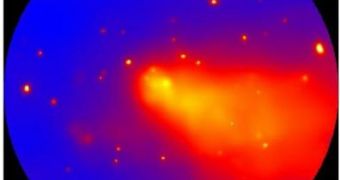A team of investigators announces the discovery of a massive, ring-like structure surrounding the large galaxy supercluster Abell 3376. The formation provides additional insights into how such large space objects form and keep themselves together.
In order to peer deep into the Universe – and get as much resolution into the new datasets as possible – experts used the Very Large Array (VLA) radio telescope, which is operated by the US National Science Foundation (NSF).
The research group says that the new data may also help shed some more light on the behaviors displayed by magnetic fields in the massive expanses of space between galaxies and clusters.
Experts add that the new observations may even help cast a new perspective on the origin of cosmic rays, high-energy bursts of light whose sources are now only superficially understood.
In the image attached to this article, a massive burst of X-rays is made visible. The photo was snapped using the European Space Agency’s (ESA) XMM-Newton telescope, and shows a bullet-shaped cloud of radiation that is most likely produced by superheated gas.
Measurements indicate that the gas clouds need to be heated to about 60 million degrees Kelvin in order to produce this effect. Astronomers believe that these conditions arise from a collision between the supercluster and a smaller cluster. The two are currently merging together.
“These giant, radio-emitting rings probably are the result of shock waves caused by violent collisions of smaller groups of galaxies within the cluster,” explains researcher Joydeep Bagchi.
The expert – who led the international team behind the new work, is based at the Inter-University Centre for Astronomy and Astrophysics in Pune, India. Details of the work appear in a recent issue of the top journal Science.
The ring-shaped structures are located an estimated 600 million light-years from Earth, and have a diameter of at least 6 million light-years. For comparison, our galaxy is 120,000 light-years across, Daily Galaxy reports.
“Our X-ray observations strongly suggest a recent collision and merger of two or more smaller clusters. Such a phenomenon is among the most energetic events in the Universe after the Big Bang,” adds Florence Durret.
“Only a tiny fraction of the total energy of this collision, if transferred to electrons, would cause them to emit the radio waves observed by the VLA. However, the main question is, how this is achieved,” adds the expert, who is based at the Astrophysical Institute of Paris, France.

 14 DAY TRIAL //
14 DAY TRIAL //